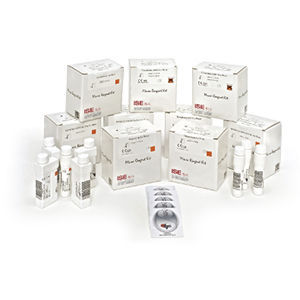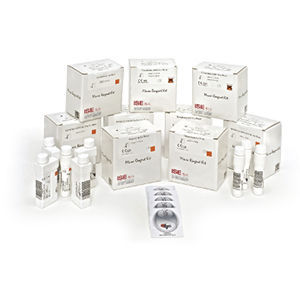
Solution reagent kit A-R0100000101 blood samplefor clinical chemistrytotal bilirubin
Add to favorites
Compare this product
fo_shop_gate_exact_title
Characteristics
- Type
- solution
- Applications
- blood sample, for clinical chemistry
- Tested parameter
- total bilirubin
Description
Product for use in the quantitative determination in vitro of the concentration of the Total
Bilirubin in human serum or plasma. The results of the test must always be interpreted
in conjunction with the clinical context. For professional use only.
CLINICAL SIGNIFICANCE
Approximately 80-85 % of the bilirubin produced is derived from the heme moiety of the
haemoglobin released from aging erythrocytes in the reticuloendothelial cells. Bilirubin,
bound to albumin, is transported into the liver where it is rapidly conjugated with
glucuronide to increase its solubility. Then it is excreted into biliary canaliculi, and
hydrolyzed in the gastrointestinal tract.
Unconjugated bilirubin serum concentration increases in case of overproduction of
bilirubin (acute or chronic haemolytic aniemias) and in case of disorders of bilirubin
metabolism and transport defects (impaired uptake by liver cells: Gilbert’s syndrome;
defects in the conjucation reaction: Crigler-Najjar syndrome). Reduced excretion
(hepatocellular damage: hepatitis, cirrhosis, Dubin-Johnson and Rotor syndrome) and
obstruction to the flow of bile (most often produced by gallstones or by tumors) induce
an important elevation of conjugated bilirubin and in a minor extent an increase of
unconjugated bilirubin (conjugated hyperbilirubinemia).
Catalogs
No catalogs are available for this product.
See all of ISE‘s catalogsRelated Searches
- Solution reagent kit
- Laboratory reagent kit
- Protein reagent kit
- Clinical chemistry reagent
- Antibody
- Clinical chemistry analyzer
- Automatic clinical chemistry analyzer
- Blood sample reagent kit
- Benchtop clinical chemistry analyzer
- Electrolyte reagent kit
- Blood clinical chemistry analyzer
- Enzyme reagent
- Random access biochemistry analyzer
- Clinical chemistry analyzer with ISE
- Serum clinical chemistry analyzer
- Plasma clinical chemistry analyzer
- Biochemistry analyzer with touchscreen
- Compact clinical chemistry analyzer
- Reagent for antigens
- Urine clinical chemistry analyzer
*Prices are pre-tax. They exclude delivery charges and customs duties and do not include additional charges for installation or activation options. Prices are indicative only and may vary by country, with changes to the cost of raw materials and exchange rates.







